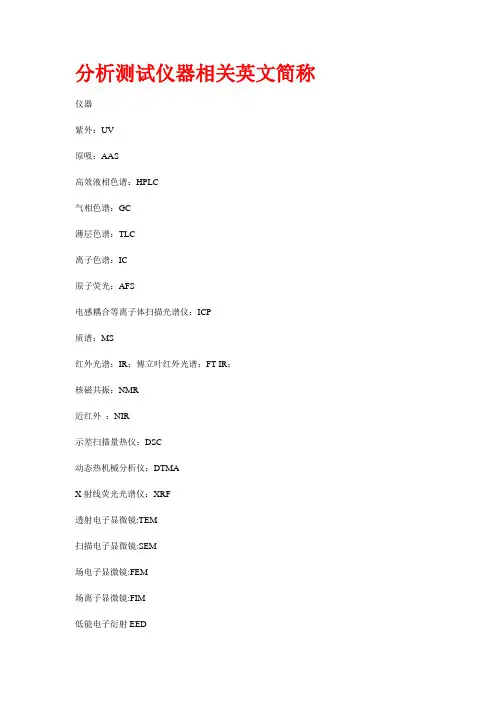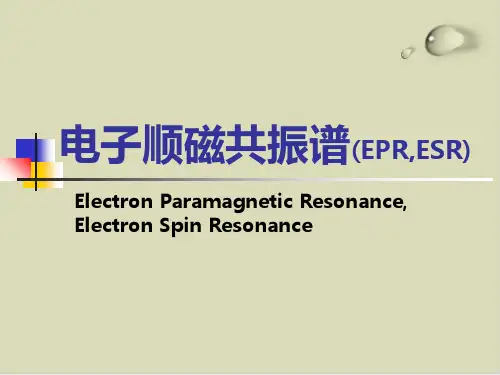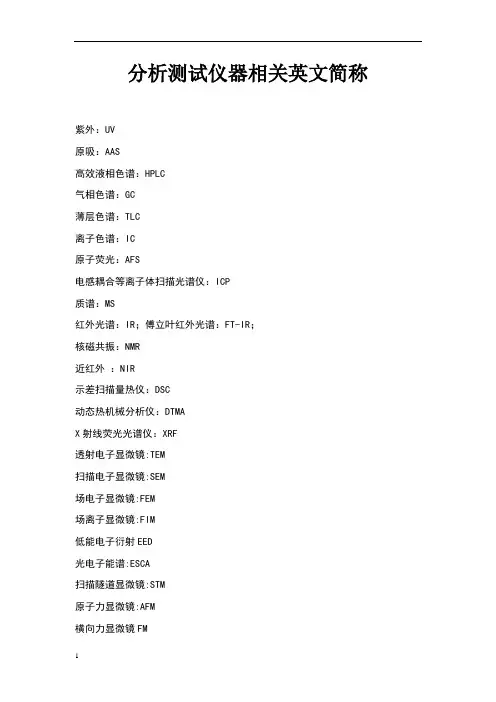High-frequency electron paramagnetic resonance investigation of the Fe3+ impurity center in
ESR简介

自旋捕捉剂和自旋标记
亚硝基化合物
自旋捕捉剂和自旋标记
氮氧化合物
稳定自由基谱
应用举例1:初级自由基研究
有机过氧化氢与N,N-二甲胺
应用举例2:初级自由基研究
过硫酸铵 (NH4)2S2O8和 脂肪环叔胺N甲基吗啡啉/ 脂肪环仲胺吗 啡啉
超精细结构 (Hyperfine Coupling)
未成对电子之间偶合 未成对电子与磁核之间偶合
偶极-偶极偶合----各向异性 费米接触----各向同性:s轨道
Electron
S (½)
Nucleus
I (½) Hyperfine Coupling
MS=±½
Ms +½
DE1
MI +½
三重态分子(triplet molecule):这种化合物的分子轨 道中含有两个未成对电子,且相距很近,彼此之间有很强 的相互作用。如氧分子,它们可以是基态或激发态。
电子顺磁共振的研究对象
过渡金属离子和稀土离子:这类分子在原子轨道中出现 未 成 对 电 子 , 如 常 见 的 过 渡 金 属 离 子 有 Ti3+(3d1) , V3+(3d7)等。
for B = 3480 G n for B = 420 G n for B = 110 G n
= 9.75 GHz (X-band) = 1.2 GHz (L-band) = 300 MHz
g值和A值得标定
g因子和A值是EPR谱图中两个最重要的 信息,通过测试g因子和A值我们可以判 断出单电子的类型,可能得结构信息, 然后通过计算及模拟得出准确的结构。 下面是g值和A值的标注。
分析测试仪器相关英文简称

分析测试仪器相关英文简称仪器紫外:UV原吸:AAS高效液相色谱:HPLC气相色谱:GC薄层色谱:TLC离子色谱:IC原子荧光:AFS电感耦合等离子体扫描光谱仪:ICP质谱:MS红外光谱:IR;傅立叶红外光谱:FT-IR;核磁共振:NMR近红外:NIR示差扫描量热仪:DSC动态热机械分析仪:DTMAX射线荧光光谱仪:XRF透射电子显微镜:TEM扫描电子显微镜:SEM场电子显微镜:FEM场离子显微镜:FIM低能电子衍射EED光电子能谱:ESCA扫描隧道显微镜:STM原子力显微镜:AFM横向力显微镜FM扫描探针显微镜:SPMBOD:生化耗氧量COD:化学耗氧量TOC:总有机碳TIC:总无机碳AOX:可吸收卤化物仪器中文名称仪器英文名称英文缩写原子发射光谱仪Atomic Emission Spectrometer AES电感偶合等离子体发射光谱仪Inductive Coupled Plasma Emission SpectrometerICP 直流等离子体发射光谱仪Direct Current Plasma Emission Spectrometer DCP紫外-可见光分光光度计UV-Visible Spectrophotometer UV-Vis微波等离子体光谱仪Microwave Inductive Plasma Emission SpectrometerMIP原子吸收光谱仪Atomic Absorption Spectroscopy AAS原子荧光光谱仪Atomic Fluorescence Spectroscopy AFS傅里叶变换红外光谱仪FT-IR Spectrometer FTIR傅里叶变换拉曼光谱仪FT-Raman Spectrometer FTIR-Raman气相色谱仪Gas Chromatograph GC高压/效液相色谱仪High Pressure/Performance Liquid ChromatographyHPLC离子色谱仪Ion Chromatograph IC凝胶渗透色谱仪Gel Permeation Chromatograph GPC体积排阻色谱Size Exclusion Chromatograph SECX射线荧光光谱仪X-Ray Fluorescence Spectrometer XRFX射线衍射仪X-Ray Diffractomer XRD同位素X荧光光谱仪Isotope X-Ray Fluorescence Spectrometer电子能谱仪Electron Energy Disperse Spectroscopy能谱仪Energy Disperse Spectroscopy EDS质谱仪Mass Spectrometer MS核磁共振波谱仪Nuclear Magnetic Resonance Spectrometer NMR电子顺磁共振波谱仪Electron Paramagnetic Resonance Spectrometer ESR 极谱仪Polarograph伏安仪Voltammerter自动滴定仪Automatic Titrator电导仪Conductivity MeterpH计pH Meter水质分析仪Water Test Kits电泳仪Electrophoresis System表面科学Surface Science电子显微镜Electro Microscopy光学显微镜Optical Microscopy金相显微镜Metallurgical Microscopy扫描探针显微镜Scanning Probe Microscopy表面分析仪Surface Analyzer无损检测仪Instrument for Nondestructive Testing物性分析Physical Property Analysis热分析仪Thermal Analyzer粘度计Viscometer流变仪Rheometer粒度分析仪Particle Size Analyzer热物理性能测定仪Thermal Physical Property Tester电性能测定仪Electrical Property Tester光学性能测定仪Optical Property Tester机械性能测定仪Mechanical Property Tester燃烧性能测定仪Combustion Property Tester老化性能测定仪Aging Property Tester生物技术分析Biochemical analysisPCR仪Instrument for Polymerase Chain Reaction PCRDNA及蛋白质的测序和合成仪Sequencers and Synthesizers for DNA and Protein 传感器Sensors其他Other/Miscellaneous流动分析与过程分析Flow Analytical and Process Analytical Chemistry气体分析Gas Analysis基本物理量测定Basic Physics样品处理Sample Handling金属/材料元素分析仪Metal/material elemental analysis 环境成分分析仪CHN Analysis发酵罐Fermenter生物反应器Bio-reactor摇床Shaker离心机Centrifuge超声破碎仪Ultrasonic Cell Disruptor超低温冰箱Ultra-low Temperature Freezer恒温循环泵Constant Temperature Circulator超滤器Ultrahigh Purity Filter冻干机Freeze Drying Equipment部分收集器Fraction Collector氨基酸测序仪Protein Sequencer氨基酸组成分析仪Amino Acid Analyzer多肽合成仪Peptide synthesizerDNA测序仪DNA SequencersDNA合成仪DNA synthesizer紫外观察灯Ultraviolet Lamp分子杂交仪Hybridization OvenPCR仪PCR Amplifier化学发光仪Chemiluminescence Apparatus紫外检测仪Ultraviolet Detector 电泳Electrophoresis酶标仪ELIASACO2培养箱CO2 Incubators倒置显微镜Inverted Microscope 超净工作台Bechtop。
电子磁共振技术在催化研究中的应用EPR.

电子磁共振的实验方法
对象 (10) 金属酶、蛋 白、血液 (11)维生素、辅酶 (12)血液组分、组 织、食品
(13)岩石、化石
(14)煤、石油
(15)宝石(钻石、 红宝石、珍珠)
(16)玻璃、陶瓷
(17)火焰、燃烧气
未偶电子位置 金属离子、配体、活性氧 物种 自由基
光、热、压力、损伤位置
检波放大后记录下来成为EMR吸收谱,经相敏检波后再记录
下来则为EMR一次微商谱。
电子磁共振的基本原理
g因子
如果测量的是一个自由电子,则光谱分裂常数g将只是一 个常数(Lande因子ge=2.00232),并为自由电子所特有。
但是更多的场合下,电子为原子或者分子所有,参与成 键。此时,对试样施加一个外磁场,试样将产生一个局部磁 场(内磁场)。它与外部磁场相加或相减得到一个等效磁场。 任何局部磁场都可以看作是由于g因子变化造成的(g= hν/βH)。
因此,g因子的变化反应了未偶电子所在分子的特征。测 定一个未知信号的g因子有助于鉴别信号来源。
电子磁共振的基本原理
试样的g值一般在1-10之间或更大,这种偏离ge值的局部磁 场主要来源于轨道磁矩,是由于激发态掺入基态而引起的,并
以自旋-轨道耦合常数λ表示。若原子壳层小于半充满,则λ>
0,g<ge,反之则g>ge。 g因子具有各向异性,为二级张量,可以用三个主值(三g
一个未偶电子与一个核(I=1/2) 一个未偶电子与两个等性核(I1=
相互作用的能级分裂、允许跃迁、 I2=1/2)相互作用的能级分裂、允
吸收谱和一次微商谱
许跃迁、吸收谱和一次微商谱
电子磁共振的基本原理
一个未偶电子与两个不等性核(I1 =I2=1/2)相互作用的能级分裂、 允许跃迁、吸收谱和一次微商谱
【推荐】电子顺磁共振知识培训教材38

Electron Paramagnetic Resonance, Electron Spin Resonance
磁诱导电子自旋能级裂分
Ms
Ms = +½
±½
DE=hn=gbB
DBpp
Energy
B=0
Ms = -½
B>0
Magnetic Field (B)
h Planck’s constant 6.626196 x 10-27 erg.sec n frequency (GHz or MHz) g g-factor (approximately 2.0) b Bohr magneton (9.2741 x 10-21 erg.Gauss-1) B magnetic fห้องสมุดไป่ตู้eld (Gauss or mT)
for B = 3480 G n for B = 420 G n for B = 110 G n
= 9.75 GHz (X-band) = 1.2 GHz (L-band) = 300 MHz
g值和A值得标定
g因子和A值是EPR谱图中两个最重要的 信息,通过测试g因子和A值我们可以判 断出单电子的类型,可能得结构信息, 然后通过计算及模拟得出准确的结构。 下面是g值和A值的标注。
How does EPR work? DE = gb H
DE
hn
Energy
microwave source
gbH0 = hn
H1
H0
H2
External magnetic field
电子顺磁共振
在垂直于B0的方向上施加频率为hn的电 磁波,当满足hn =g b B0 时,处于两能级 间的电子发生受激跃迁,导致部分处于 低能级中的电子吸收电磁波的能量跃迁 到高能级中,这就是顺磁共振现象。受 激跃迁产生的吸收信号经电子学系统处 理可得到EPR吸谱线。 (g 因子, g e =2.0023; b波尔磁子)
实验室器材英文翻译

实验室常用英语—化学生物类1。
2. 来美国学习遇到了一个很郁闷的事:走进实验室跟别人交流非常困难,自己做实验也是磕磕碰碰.一个很大的原因就是一些实验仪器或是药品的名称不知道怎么说,以前学英文从来没有学这些内容。
郁闷之余,我在网上搜集了一些相关仪器和药品的中英对照,与大家一起学习分享,希望对学化学生物类的朋友有些帮助。
由于药品种类繁多,各人使用相关也很大,以下仅列仪器部分。
容器类:量杯measuring cup烧杯beaker 不锈钢杯stainless-steel beaker量筒measuring flask/measuring cylinder 量筒graduated flask/measuring cylinder坩埚crucible 坩埚钳crucible clamp 坩埚crucible pot,melting pot试管test tube 试管架test tube holder漏斗funnel 分液漏斗separatory funnel烧瓶flask 锥形瓶conical flask塞子stopper洗瓶plastic wash bottle滴定管burette玻璃活塞stopcock冷凝器condenser试剂瓶reagent bottles玻棒glass rod 搅拌棒stirring rod蒸馏烧瓶distilling flask碘量瓶iodine flask表面皿watch glass蒸发皿evaporating dish容量瓶volumetric flask/measuring flask移液管(one-mark) pipette刻度移液管graduated pipettes称量瓶weighing bottle吸液管pipette滤管filter天平balance/scale分析天平analytical balance台秤platform balance游码crossbeams and sliding weights酒精灯alcohol burner酒精喷灯blast alcohol burner搅拌装置stirring device洗耳球rubber suction bulb研磨钵mortar 研磨棒pestle 玛瑙研钵agate mortar瓷器porcelain白细口瓶flint glass solution bottle with stopper滴瓶dropping bottle 小滴管dropper蒸馏装置distilling apparatus蒸发器evaporator试验用器材:升降台lab jack铁架台iron support万能夹extension clamp蝴蝶夹double-buret clamp双顶丝clamp regular holder止水夹flatjaw pinchcock圆形漏斗架cast-iron ring移液管架pipet rack试管架tube rack沸石boiling stone橡胶管rubber tubing药匙lab spoon镊子forceps坩埚钳crucible tong剪刀scissor打孔器stopper borer石棉网asbestos-free wire gauze电炉丝wire coil for heater脱脂棉absorbent cottonphph试纸universal ph indicator paper滤纸filter paper称量纸weighing paper擦镜纸wiper for lens秒表stopwatch量杯glass graduates with scale白滴定管(酸)flint glass burette with glass stopcock棕色滴定管(酸)brown glass burette with glass stopcock 白滴定管(碱)flint glass burette for alkali棕色滴定管(碱)brown glass burette for alkali比重瓶specific gravity bottle水银温度计mercury—filled thermometerph计ph meter折光仪refractometer真空泵vacuum pump冷、热浴bath离心机centrifuge口罩respirator防毒面具respirator、gasmask磁力搅拌器magnetic stirrer电动搅拌器power basic stirrer烘箱oven闪点仪flash point tester马弗炉furnace电炉heater微波炉电热套heating mantleBunsen burner 本生灯product 化学反应产物apparatus 设备PH indicator PH值指示剂,氢离子(浓度的)负指数指示剂matrass 卵形瓶litmus 石蕊litmus paper 石蕊试纸burette 滴定管retort 曲颈甑still 蒸馏釜cupel 烤钵化学反应:analysis 分解fractionation 分馏endothermic reaction 吸热反应exothermic reaction 放热反应precipitation 沉淀to precipitate 沉淀to distil,to distill 蒸馏distillation 蒸馏to calcine 煅烧to oxidize 氧化alkalinization 碱化to oxygenate,to oxidize 脱氧,氧化to neutralize 中和to hydrogenate 氢化to hydrate 水合,水化to dehydrate 脱水fermentation 发酵solution 溶解combustion 燃烧fusion, melting 熔解alkalinity 碱性isomerism,isomery 同分异物现象hydrolysis 水解electrolysis 电解electrode 电极anode 阳极,正极cathode 阴极,负极catalyst 催化剂catalysis 催化作用oxidization, oxidation 氧化reducer 还原剂dissolution 分解synthesis 合成reversible 可逆的仪器中英文对照Aging Property Tester 老化性能测定仪Amino Acid Analyzer 氨基酸组成分析仪Analyzer for Clinic Medicine Concentration 临床药物浓度仪Atomic Absorption Spectroscopy 原子吸收光谱仪Atomic Emission Spectrometer 原子发射光谱仪Atomic Fluorescence Spectroscopy 原子荧光光谱仪Automatic Titrator 自动滴定仪Basic Physics 基本物理量测定Biochemical Analyzer 生化分析仪Biochemicalanalysis 生物技术分析Bio-reactor 生物反应器Blood—gas Analyzer 血气分析仪Centrifuge 离心机ChemiluminescenceApparatus 化学发光仪CHN Analysis 环境成分分析仪CO2 Incubators CO2培养箱Combustion PropertyTester 燃烧性能测定仪Conductivity Meter 电导仪Constant Temperature Circulator 恒温循环泵Direct Current Plasma Emission Spectrometer 直流等离子体发射光谱仪DNA Sequencers DNA测序仪DNA synthesizer DNA合成仪Electrical Property Tester 电性能测定仪Electro Microscopy 电子显微镜Electrolytic Analyzer 电解质分析仪Electron Energy Disperse Spectroscopy 电子能谱仪Electron Paramagnetic ResonanceSpectrometer 电子顺磁共振波谱仪Electrophoresis 电泳Electrophoresis System 电泳仪ELIASA 酶标仪Energy Disperse Spectroscopy 能谱仪Fermenter 发酵罐Flow Analytical and Process AnalyticalChemistry 流动分析与过程分析Fraction Collector 部分收集器FreezeDrying Equipment 冻干机FT—IR Spectrometer 傅里叶变换红外光谱仪FT—Raman Spectrometer 傅里叶变换拉曼光谱仪Gas Analysis 气体分析Gas Chromatograph 气相色谱仪GC—MS 气相色谱-质谱联用仪Gel PermeationChromatograph 凝胶渗透色谱仪HighPressure/Performance Liquid Chromatography 高压/效液相色谱仪Hybridization Oven 分子杂交仪ICP-MS ICP—质谱联用仪Inductive Coupled Plasma Emission Spectrometer 电感偶合等离子体发射光谱仪Instrument for Nondestructive Testing 无损检测仪Instrument for Polymerase Chain Reaction PCR仪Inverted Microscope 倒置显微镜Ion Chromatograph 离子色谱仪Isotope X-Ray Fluorescence Spectrometer 同位素X荧光光谱仪LC-MS 液相色谱-质谱联用仪Mass Spectrometer 质谱仪Mechanical Property Tester 机械性能测定仪Metal/material elemental analysis 金属/材料元素分析仪Metallurgical Microscopy 金相显微镜Microwave Inductive Plasma Emission Spectrometer 微波等离子体光谱仪Nuclear Magnetic Resonance Spectrometer 核磁共振波谱仪Optical Microscopy 光学显微镜Optical PropertyTester 光学性能测定仪Other/Miscellaneous 其他Particle Size Analyzer 粒度分析仪PCR Amplifier PCR仪Peptide synthesizer 多肽合成仪pH Meter pH计PhysicalProperty Analysis 物性分析Polarograph 极谱仪Protein Sequencer 氨基酸测序仪Rheometer 流变仪Sample Handling 样品处理Scanning Probe Microscopy FG|8oU 扫描探针显微镜Sensors 传感器Sequencers and Synthesizers for DNA and Protein DNA及蛋白质的测序和合成仪Shaker 摇床Size Exclusion Chromatograph 体积排阻色谱Surface Science 表面科学SurfaceAnalyzer 表面分析仪Thermal Analyzer 热分析仪Thermal Physical Property Tester 热物理性能测定仪Ultrahigh Purity Filter 超滤器Ultra—low Temperature Freezer 超低温冰箱Ultrasonic Cell Disruptor 超声破碎仪Ultraviolet Detector 紫外检测仪UltravioletLamp 紫外观察灯Urine Analyzer 尿液分析仪UV-Visible Spectrophotometer 紫外-可见光分光光度计Viscometer 粘度计Voltammerter 伏安仪Water Test Kits 水质分析仪X—Ray Fluorescence Spectrometer X射线荧光光谱仪X—RayDiffractomer X射线衍射仪。
分析仪器相关英文简称

分析测试仪器相关英文简称紫外:UV原吸:AAS高效液相色谱:HPLC气相色谱:GC薄层色谱:TLC离子色谱:IC原子荧光:AFS电感耦合等离子体扫描光谱仪:ICP质谱:MS红外光谱:IR;傅立叶红外光谱:FT-IR;核磁共振:NMR近红外:NIR示差扫描量热仪:DSC动态热机械分析仪:DTMAX射线荧光光谱仪:XRF透射电子显微镜:TEM扫描电子显微镜:SEM场电子显微镜:FEM场离子显微镜:FIM低能电子衍射EED光电子能谱:ESCA扫描隧道显微镜:STM原子力显微镜:AFM横向力显微镜FM扫描探针显微镜:SPMBOD:生化耗氧量COD:化学耗氧量TOC:总有机碳TIC:总无机碳AOX:可吸收卤化物仪器中文名称仪器英文名称英文缩写原子发射光谱仪 Atomic Emission Spectrometer AES电感偶合等离子体发射光谱仪Inductive Coupled Plasma Emission SpectrometerICP直流等离子体发射光谱仪 Direct Current Plasma Emission Spectrometer DCP 紫外-可见光分光光度计 UV-Visible Spectrophotometer UV-Vis微波等离子体光谱仪 Microwave Inductive Plasma Emission SpectrometerMIP 原子吸收光谱仪 Atomic Absorption Spectroscopy AAS原子荧光光谱仪 Atomic Fluorescence Spectroscopy AFS傅里叶变换红外光谱仪 FT-IR Spectrometer FTIR傅里叶变换拉曼光谱仪 FT-Raman Spectrometer FTIR-Raman气相色谱仪 Gas Chromatograph GC高压/效液相色谱仪 High Pressure/Performance Liquid ChromatographyHPLC 离子色谱仪 Ion Chromatograph IC凝胶渗透色谱仪 Gel Permeation Chromatograph GPC体积排阻色谱 Size Exclusion Chromatograph SECX射线荧光光谱仪 X-Ray Fluorescence Spectrometer XRFX射线衍射仪 X-Ray Diffractomer XRD同位素X荧光光谱仪 Isotope X-Ray Fluorescence Spectrometer电子能谱仪 Electron Energy Disperse Spectroscopy能谱仪 Energy Disperse Spectroscopy EDS质谱仪 Mass Spectrometer MS核磁共振波谱仪 Nuclear Magnetic Resonance Spectrometer NMR电子顺磁共振波谱仪 Electron Paramagnetic Resonance Spectrometer ESR 极谱仪 Polarograph伏安仪 Voltammerter自动滴定仪 Automatic Titrator电导仪 Conductivity MeterpH计 pH Meter水质分析仪 Water Test Kits电泳仪 Electrophoresis System表面科学 Surface Science电子显微镜 Electro Microscopy光学显微镜 Optical Microscopy金相显微镜 Metallurgical Microscopy扫描探针显微镜 Scanning Probe Microscopy表面分析仪 Surface Analyzer无损检测仪 Instrument for Nondestructive Testing物性分析 Physical Property Analysis热分析仪 Thermal Analyzer粘度计 Viscometer流变仪 Rheometer粒度分析仪 Particle Size Analyzer热物理性能测定仪 Thermal Physical Property Tester电性能测定仪 Electrical Property Tester光学性能测定仪 Optical Property Tester机械性能测定仪 Mechanical Property Tester燃烧性能测定仪 Combustion Property Tester老化性能测定仪 Aging Property Tester生物技术分析 Biochemical analysisPCR仪 Instrument for Polymerase Chain Reaction PCRDNA及蛋白质的测序和合成仪 Sequencers and Synthesizers for DNA and Protein 传感器 Sensors其他 Other/Miscellaneous流动分析与过程分析 Flow Analytical and Process Analytical Chemistry气体分析 Gas Analysis基本物理量测定 Basic Physics样品处理 Sample Handling金属/材料元素分析仪 Metal/material elemental analysis环境成分分析仪 CHN Analysis发酵罐 Fermenter生物反应器 Bio-reactor摇床 Shaker离心机 Centrifuge超声破碎仪 Ultrasonic Cell Disruptor超低温冰箱 Ultra-low Temperature Freezer恒温循环泵 Constant Temperature Circulator超滤器 Ultrahigh Purity Filter冻干机 Freeze Drying Equipment部分收集器 Fraction Collector氨基酸测序仪 Protein Sequencer氨基酸组成分析仪 Amino Acid Analyzer 多肽合成仪 Peptide synthesizerDNA测序仪 DNA SequencersDNA合成仪 DNA synthesizer紫外观察灯 Ultraviolet Lamp分子杂交仪 Hybridization OvenPCR仪 PCR Amplifier化学发光仪 Chemiluminescence Apparatus 紫外检测仪 Ultraviolet Detector电泳 Electrophoresis酶标仪 ELIASACO2培养箱 CO2 Incubators倒置显微镜 Inverted Microscope超净工作台 Bechtop。
Electron paramagnetic resonance spectroscopy
Electron paramagnetic resonance spectroscopy IntroductionThe term electron paramagnetic resonance (EPR) encompasses a family of techniques based on the absorption of electromagnetic radiation in the microwave frequency region by a paramagnetic sample placed in a magnetic field. EPR has abroad range of applications in catalysis and related fields as it represents a very powerful tool for investigating paramagnetic entities. the first EPR experiment was performed by E.K.Zavoisky in 1945,observing the resonance of CuCl2.2H2O with a radiofrequency source operating at 133 MHZ and a magnetic field provided by a solenoid. The limitation of EPR is evident from the previous definition in that diamagnetic systems, which represent the majority of the substances, are excluded from EPR investigations. However, this limitation is also an advantage since, for instance, reactive paramagnetic intermediates or paramagnetic centers belonging to a complex chemical system (e.g.,a paramagnetic ion in a zeolitic network) can be studied without any interference. The relevant information provided by EPR concerns the nature, symmetry, and electronic structure of the paramagnetic center and of its surrounding. A second advantage of EPR, apart from its specificity, is its high sensitivity, which, in the investigations of solid surfaces, allows the detection of paramagnetic species in concentrations well below monolayer coverage. The firstapplications of EPR in the field of surface chemistry and heterogeneous catalysis were reported at the beginning of the 1960s. since then, review articles oriented towards catalytic phenomena have appeared periodically in the literature .9.1.1Interaction of matter with a magnetic fieldBefore describing the concepts of EPR spectroscopy, it must be recalled that a paramagnetic body, when placed in a magnetic field, increases the magnetic flus density (or magnetic induction, B) within its own volume. In contrast, a diamagnetic substance slightly decreases the magnetic flux density . diamagnetism is present in all substances and is produced by electron circulation in atoms, ions, and molecules having a closed shell of electrons under the influence of a magnetic field. Paramagnetism is typical of substances having centers with one or more unpaired electrons and, therefore, bearing an intrinsic angular momentum – the spin – and a corresponding magnetic moment .Whereas in the absence of an external magnetic field the unpaired electrons of each paramagnetic center are aligned randomly ,in the presence of such a field (B) the magnetic moments of different centers tend to align with the field and hence with each other. In such conditions, the system acquires a magnetization M,related to the difference between the number of electrons in the two allowed spin states(i.e.,with magnetic moments aligned and counter-aligned with respect to the magnetic field vector, respectively).this aligning effect is contrasted by the randomizing effect of thermal energy. The magnetization or alternatively the magnetic susceptibility (R gama) .(x=m/h, where h is the strength of magnetic field) therefore tends to increase by lowering the temperature according to the curie law .x=c/t, c being a constant and t the temperature.Electron magnetic resonance occurs when an electromagnetic wave of suitable frequency (usually in the microwave region) interacts with the sample immersed in a magnetic field and causes the inversion of the spin (and thus of the magnetic moment) of the unpaired electrons, so that a certain amount of the electromagnetic energy is absorbed by the system. In quantum mechanical terms, the description of the electron spin resonance can be reduced to the description of the behavior of a single unpaired electron undergoing, under the effect of an external magnetic field , an energy splitting between the two allowed spin states. In such conditions, an electron in the lower state is promoted to the upper state by absorption of a photon of suitable energy.9.1.2Experimental approaches in EPRIn most molecular spectroscopy techniques, the electric field component of the radiation interacts with an electric dipole moment inthe molecules. In magnetic resonance spectroscopy, in contrast, it is the magnetic component of the radiation that interacts with magnetic dipoles of paramagnetic centers. There are two approaches to record EPR spectra: in the more common one, low-intensity microwave radiation continuously irradiates the sample (continuous-wave or CW-EPR). In the second approach ,pulses of high-pwer microwave radiation are sent to the sample and the response is recorded in the absence of radiation (pluse- EPR). Since the majority of the EPR applications to surface chemistry and catalysis employ CW-EPR, this technique will be mainly described here. In a CW-EPR experiment with the sample under irradiation with microwaves having fixed frequency. A given range of the magnetic field is swept to reach the condition of magnetic resonance, A CW-EPR spectrum is therefore a diagram where the microwave absorption ,or more commonly ,its first derivative is reported as a function of the magnetic field swept in the experiment. It usually consists of several。
湖南大学高等分析化学名词解释
AAS:Atomic Absorption Spectroscopy原子吸收光谱:基于气态的基态原子外层电子对紫外光和可见光范围的相对应原子共振辐射线的吸收强度来定量被测元素含量为基础的分析方法AES:Atomic Emission Spectrometry原子发射光谱:利用物质在热激发或电激发下,每种元素的原子或离子发射特征光谱来判断物质的组成,而进行元素的定性与定量分析的方法AFM:Atomic Force Microscope原子力显微镜:利用微小探针与待测物之间作用力,通过将激光束照射到微悬臂上,进行反射及反馈呈现待测物表面形貌和物理特征的仪器。
AFP:alpha fetoprotein甲胎蛋白:原发性肝癌的高特异性和高灵敏度的肿瘤标志物AFS:Atomic fluorescence Spectroscopy原子荧光光谱:原子在辐射能激发下发射的荧光强度进行定量分析的发射光谱分析法ASV: anodic stripping voltammetry阳极溶出伏安法:在一定的电位下,使待测金属离子部分地还原成金属并溶入微电极或析出于电极的表面,然后向电极施加反向电压,使微电极上的金属氧化而产生氧化电流,根据氧化过程的电流一电压曲线进行分析的伏安法。
ATP:Adenosine triphosphate三磷酸腺苷:由腺嘌呤、核糖和3个磷酸基团连接而成的高能化合物,水解时释放出较多能量,是生物体内最直接的能量来源。
ATR:Attenuated Total Reflection衰减全反射法:光波由光密介质向光疏介质入射并在界面上全反射时,光疏介质中所形成的迅衰场(量可以被耦合到金属或半导体的表面上而使反射光强减小,通过检测反射光信息,获得样品相关信息的方法AuNP:Au nanoparticle金纳米颗粒:制成大小在1-100nm范围内的金的纳米颗粒,是一种常用的免疫标记物BOD:Biochemical oxygen demand生化需氧量:在一定期间内,微生物分解一定体积水中的某些可被氧化物质,特别是有机物质,所消耗的溶解氧的数量BSA:Albumin from Bovine albumin牛血清蛋白:是一种常用的酶的稳定剂,起保护或载体作用CAE:capillary array electrophoresis毛细管阵列电泳:是一种实现了阵列化,能完成同时对大量样品的分离分析的高通量毛细管电泳技术。
分析仪器相关英文简称
分析测试仪器相关英文简称紫外:UV原吸:AAS高效液相色谱:HPLC气相色谱:GC薄层色谱:TLC离子色谱:IC原子荧光:AFS电感耦合等离子体扫描光谱仪:ICP质谱:MS红外光谱:IR;傅立叶红外光谱:FT-IR;核磁共振:NMR近红外:NIR示差扫描量热仪:DSC动态热机械分析仪:DTMAX射线荧光光谱仪:XRF透射电子显微镜:TEM扫描电子显微镜:SEM场电子显微镜:FEM场离子显微镜:FIM低能电子衍射EED光电子能谱:ESCA扫描隧道显微镜:STM原子力显微镜:AFM横向力显微镜FM扫描探针显微镜:SPMBOD:生化耗氧量COD:化学耗氧量TOC:总有机碳TIC:总无机碳AOX:可吸收卤化物仪器中文名称仪器英文名称英文缩写原子发射光谱仪 Atomic Emission Spectrometer AES电感偶合等离子体发射光谱仪Inductive Coupled Plasma Emission SpectrometerICP直流等离子体发射光谱仪 Direct Current Plasma Emission Spectrometer DCP 紫外-可见光分光光度计 UV-Visible Spectrophotometer UV-Vis微波等离子体光谱仪 Microwave Inductive Plasma Emission SpectrometerMIP 原子吸收光谱仪 Atomic Absorption Spectroscopy AAS原子荧光光谱仪 Atomic Fluorescence Spectroscopy AFS傅里叶变换红外光谱仪 FT-IR Spectrometer FTIR傅里叶变换拉曼光谱仪 FT-Raman Spectrometer FTIR-Raman气相色谱仪 Gas Chromatograph GC高压/效液相色谱仪 High Pressure/Performance Liquid ChromatographyHPLC 离子色谱仪 Ion Chromatograph IC凝胶渗透色谱仪 Gel Permeation Chromatograph GPC体积排阻色谱 Size Exclusion Chromatograph SECX射线荧光光谱仪 X-Ray Fluorescence Spectrometer XRFX射线衍射仪 X-Ray Diffractomer XRD同位素X荧光光谱仪 Isotope X-Ray Fluorescence Spectrometer电子能谱仪 Electron Energy Disperse Spectroscopy能谱仪 Energy Disperse Spectroscopy EDS质谱仪 Mass Spectrometer MS核磁共振波谱仪 Nuclear Magnetic Resonance Spectrometer NMR电子顺磁共振波谱仪 Electron Paramagnetic Resonance Spectrometer ESR 极谱仪 Polarograph伏安仪 Voltammerter自动滴定仪 Automatic Titrator电导仪 Conductivity MeterpH计 pH Meter水质分析仪Water Test Kits电泳仪Electrophoresis System表面科学Surface Science电子显微镜Electro Microscopy光学显微镜Optical Microscopy金相显微镜Metallurgical Microscopy扫描探针显微镜Scanning Probe Microscopy表面分析仪Surface Analyzer无损检测仪Instrument for Nondestructive Testing物性分析Physical Property Analysis热分析仪Thermal Analyzer粘度计Viscometer流变仪Rheometer粒度分析仪Particle Size Analyzer热物理性能测定仪Thermal Physical Property Tester电性能测定仪Electrical Property Tester光学性能测定仪Optical Property Tester机械性能测定仪Mechanical Property Tester燃烧性能测定仪Combustion Property Tester老化性能测定仪Aging Property Tester生物技术分析Biochemical analysisPCR仪Instrument for Polymerase Chain Reaction PCRDNA及蛋白质的测序和合成仪Sequencers and Synthesizers for DNA and Protein 传感器Sensors其他Other/Miscellaneous流动分析与过程分析Flow Analytical and Process Analytical Chemistry气体分析Gas Analysis基本物理量测定Basic Physics样品处理Sample Handling金属/材料元素分析仪Metal/material elemental analysis环境成分分析仪CHN Analysis发酵罐Fermenter生物反应器Bio-reactor摇床Shaker离心机Centrifuge超声破碎仪Ultrasonic Cell Disruptor超低温冰箱Ultra-low Temperature Freezer恒温循环泵Constant Temperature Circulator超滤器Ultrahigh Purity Filter冻干机Freeze Drying Equipment部分收集器Fraction Collector氨基酸测序仪Protein Sequencer氨基酸组成分析仪Amino Acid Analyzer多肽合成仪Peptide synthesizerDNA测序仪DNA SequencersDNA合成仪DNA synthesizer紫外观察灯Ultraviolet Lamp分子杂交仪Hybridization OvenPCR仪PCR Amplifier化学发光仪Chemiluminescence Apparatus紫外检测仪Ultraviolet Detector电泳Electrophoresis酶标仪ELIASACO2培养箱CO2 Incubators倒置显微镜Inverted Microscope超净工作台Bechtop。
基于电磁波的煤岩识别技术研究进展
基于电磁波的煤岩识别技术研究进展柳圆, 司垒, 王忠宾, 魏东, 顾进恒(中国矿业大学 机电工程学院,江苏 徐州 221116)摘要:将电磁波应用于煤岩识别中,可有效提高煤岩界面分辨能力。
结合煤岩界面模型,阐述了运用电磁波技术进行煤岩识别的原理;介绍了γ射线法、雷达探测法、太赫兹信号法、电子共振法、X 射线法和红外热成像法6种具体的煤岩识别方法,分析了各方法的原理,对各方法的优缺点及煤矿井下适用性进行了对比,并结合实际工业应用分析了各方法的研究现状。
γ射线法在探测距离上具有显著优势,但存在放射性问题,基本被淘汰;雷达探测法具有识别准确的优点,但由于其信号衰减严重,探测距离短,目前一般应用于薄煤层测厚;太赫兹信号法探测距离短,只有在井下环境组成稳定时才能应用;电子共振法信号衰减严重,探测距离较短且难度较大,所以目前矿井基本摒弃;X 射线法穿透性强,成像较清晰,但危害性极大;红外热成像法中,主动红外激励法需耗费大量时间对煤岩进行激励,且在处于高瓦斯的矿井环境中,存在极大的安全隐患;截割闪温法虽耗时较短,但对于截齿多、排布复杂的情况很难实现有效的煤岩识别。
指出电磁波回波信息决定着电磁波煤岩识别的准确性,后续应对其进行深层次挖掘。
关键词:煤岩识别;电磁波;γ射线法;雷达探测法;太赫兹信号法;电子共振法;X 射线法;红外热成像法中图分类号:TD823 文献标志码:AResearch progress on coal rock recognition technology based on electromagnetic wavesLIU Yuan, SI Lei, WANG Zhongbin, WEI Dong, GU Jinheng(School of Mechatronic Engineering, China University of Mining and Technology, Xuzhou 221116, China)Abstract : Applying electromagnetic waves to coal rock recognition can effectively improve the resolution capability of coal rock interfaces. Based on the coal rock interface model, the principle of using electromagnetic wave technology for coal rock recognition is explained. The paper introduces six methods for coal rock recognition, including γ–ray method, radar detection method, Terahertz signal method, electron resonance method,X-ray method, and infrared thermal imaging method. The principles of each method are analyzed, and the advantages and disadvantages of each method are compared as well as their applicability in coal mines underground. The research status of each method is analyzed in combination with practical industrial applications.The γ–ray method has significant advantages in detection distance, but it has radiation problems. It is basically eliminated. The radar detection method has the advantage of accurate recognition, but due to its severe signal attenuation and short detection distance, it is currently generally used for thickness measurement in thin coal seams. The Terahertz signal method has a short detection distance and can only be applied when the composition of the underground environment is stable. The electronic resonance method has severe signal attenuation, short收稿日期:2023-07-26;修回日期:2024-01-10;责任编辑:胡娴。
- 1、下载文档前请自行甄别文档内容的完整性,平台不提供额外的编辑、内容补充、找答案等附加服务。
- 2、"仅部分预览"的文档,不可在线预览部分如存在完整性等问题,可反馈申请退款(可完整预览的文档不适用该条件!)。
- 3、如文档侵犯您的权益,请联系客服反馈,我们会尽快为您处理(人工客服工作时间:9:00-18:30)。
a r X i v :c o n d -m a t /0411167v 1 [c o n d -m a t .m t r l -s c i ] 8 N o v 2004High-frequency electron paramagnetic resonance investigation of the Fe 3+impuritycenter in polycrystalline PbTiO 3in its ferroelectric phaseHrvoje Meˇs tri´c ,R¨u diger-A.Eichel,∗and K.-P.DinseEduard-Zintl-Institute,Darmstadt University of Technology,D-64287Darmstadt,GermanyAndrew Ozarowski,Johan van Tol,and Louis Claude BrunelCenter for Interdisciplinary Magnetic Resonance,National High Magnetic Field Laboratory,Florida State University,Tallahassee,FL 32310(Dated:2nd February 2008)The intrinsic iron(III)impurity center in polycrystalline lead titanate (PbTiO 3)was investigated by means of high-frequency electron paramagnetic resonance (EPR)spectroscopy in order to deter-mine the local-environment sensitive fine structure (FS)parameter D .At a spectrometer frequency of 190GHz,spectral analysis of a powder sample was unambiguously possible.The observed mean value D =+35.28GHz can be rationalized if Fe 3+ions substitute for Ti 4+at the B-site of theperovskite ABO 3lattice forming a directly coordinated Fe ′Ti −V ••O defect associate.A consistent fit of the multi-frequency data necessitated use of a distribution of D values with a variance of about 1GHz.This statistical distribution of values is probably related to more distant defects and vacancies.PACS numbers:61.72.Ji,61.72.Hh,61.72.Ww,76.30.Fc,77.84.DyKeywords:lead titanate ferroelectrics,iron impurity center,oxygen vacancies,high-field EPRJ.Appl.Phys.Vol.96,No.12,15December 2004I.INTRODUCTIONLead titanate (PbTiO 3,PT)is widely used as func-tional ceramic because of its excellent physical and elec-tromechanical properties 1,2,3,4.It is a ’displacive-type’ferroelectric material that can be used as dielectric in capacitors and as high refractive index thin film for electrooptical components.Its piezoelectric and pyro-electric properties can be utilized in sensors,piezoelec-tric actuators and detectors for infrared radiation.As compared to the solid solution system lead zirconate titanate(Pb[Zr x Ti 1−x ]O 3,PZT),lead titanate exhibits a higher Curie temperature (T C =763K)and a lower di-electric constant of about 200,rendering it more attrac-tive for high-temperature and high-frequency transducer applications.In order to improve material properties,several tran-sition metals or rare-earth elements may be added on a percentage level,for which reason considerable interest exists to characterize the role of such extrinsic functional centers.Generally,standard bulk characterization tech-niques fail due to the inherent low concentration of these centers and electron paramagnetic resonance (EPR)be-comes the method-of-choice because of its high sensitiv-ity and selectivity 6.In particular,if doping with iron is considered,the local symmetry can be explored by monitoring the resulting fine structure (FS)interaction,which will be modified by the presence of oxygen va-cancies (V ••O )7.If charge compensation occurs in the nearest-neighbor O 2−ion shell,a large distortion of the octahedral symmetry results and because of the short distance a large change of the intrinsic Fe 3+FS tensorwill be induced 8.Unless crystalline samples are available,these tensor elements in general are not directly accessible at X-band (9.4GHz)frequencies,since the resulting zero-field split-ting (ZFS)is much larger than the microwave (mw)quan-tum energy.FS values therefore have to be deduced from the analysis of second-order line shifts in a fully resolved single crystal spectrum.If only powder samples are avail-able,high-frequency EPR has to be invoked in order to approach high-field conditions,under which an accurate determination of the principal value D of the FS interac-tion (including sign)via first-order effects is possible.Beyond its technical importance,we can use lead ti-tanate as a model system related to the considerably more complex acceptor-doped PZT system 5,because its structure being comparatively simple and well defined.Furthermore,a prerequisite for an analysis of the EPR spectra of solid-solution PZT systems with varying Pb/Zr composition is a complete characterization of the spec-tra of pure compounds.As stated above,in general it is quite difficult to extract large ZFS tensor elements from X-band EPR powder spectra.In order to establish high-frequency EPR as reliable tool for the investigation of technologically relevant polycrystalline compounds,we have chosen the ubiquitous Fe 3+impurity center in lead titanate powder as first example,because FS parame-ters have been obtained by previous single crystal studies which can be used for comparison.The first EPR spectrum,attributed to Fe 3+in PbTiO 3led to the discovery of an unusual high FS splitting 9.This observation was related to the strong tetragonal fer-roelectric distortion of the crystalline field.At Q-band (35GHz),two different iron centers were observed,one of them being assigned to a partially charge-compensatedFe ′Ti −V ••O defect associate.It was also observed that the2FS interaction increases by20%when cooling from room temperature to77K,consistent with a change in lattice deformation,the c/a ratio changing by19%in this tem-perature range.The spectra allowed also for the deter-mination of additional terms attributed to higher-rank tensor elements.The temperature dependence of line intensities at liquid helium temperatures indicated that the sign of D is positive10.At70GHz,additional tran-sitions could be observed and allowed to refine the ZFS parameters11.In contrast to thesefindings,in a recent X-band EPR study only a single Fe3+center was observed, for which charge compensation was assumed to occur at distant spheres12.This discrepancy was attributed to different synthesis techniques involved in manufacturing the crystals.At low temperatures hyperfine structure, assigned to interaction with nearby207Pb nuclei was ob-served.The reported ZFS parameters are spread over a broad range.Since many attempts for gaining structural in-formation about the dopant site,such as the assignment to either Fe′Ti−V••O defect associates or not-coordinated ’free’Fe′Ti centers with or without off-center shifts of the iron ion,are based upon size and sign of the ZFS pa-rameters,their precise determination is of considerable importance.By taking the reported interval of ZFS pa-rameters as input parameters for modelling the struc-ture of the iron center,a contradictory variety of pro-posed structures results,ranging from’free’Fe′Ti centers to Fe′Ti−V••O defect associates with off-center shifts to-wards or away from the oxygen vacancy.In this work, we hence aim for an unambiguous determination of the ZFS parameter by application of high-frequency EPR up to190GHz,thus creating the basis for an accurate mod-elling of the structure.In the magneticfield range of2to 8T used,the electron Zeeman energy will be the domi-nant term in the spin Hamiltonian.Resulting quantiza-tion approximately along thefield direction significantly simplifies the EPR spectrum.Accordingly it is possi-ble to accurately determine ZFS parameters of Fe3+in polycrystalline PbTiO3from observed van Hove singular-ities,which are related to canonical orientations of the compound.High frequency EPR thus is an indispens-able tool for the investigation of technologically relevant PZT,which are commonly available only as disordered compounds.II.EXPERIMENTAL9.5GHz continuous wave(c.w.)EPR measurements were performed using a ESP300E spectrometer(Bruker), equipped with a rectangular TE112resonator.The mag-neticfield was read out with a NMR gaussmeter(ER 035M,Bruker)and as a standardfield marker polycrys-talline DPPH with g=2.0036was used for the exact determination of the resonance magneticfield values. High-frequency EPR measurements were performed at the National High Magnetic Field Laboratory(NHMFL)Tallahassee13.The set-up used operates in transmission mode and employs oversized cylindrical wave guides.No resonator was used.Microwave detection was performed with a low-noise,fast response InSb hot-electron bolome-ter(QMC Ltd.),operated at liquid-helium temperature. Field modulation in the range of10to50kHz was used to obtain’first-derivative’type EPR spectra.III.THEORETICAL DESCRIPTIONIn principle,a discussion of the Fe3+center in its high-spin form(S=52D =3D⊥. The free Fe3+ion has a3d56S5/2ground state.Under the action of a tetragonal crystallinefield,this ground state splits into three twofold degenerate levels(cf.fig-ure1(a)).3 In case of the commonly employed X-band frequen-cies,the zero-field splitting is much larger than the elec-tron Zeeman energy.All doublets are well separated andonly transitions within each doublet can be observed.Accordingly,the spectrum then is described by defin-ing a separate effective spin Hamiltonian with S′=12and|±32 states are split withg′≈6.Due to the selection rule all transitions,exceptthe|m S=+12 transition are’forbidden’andwill not be observed in the X-band EPR spectrum.IV.RESULTS AND DISCUSSIONA typical X-band EPR spectrum is presented infig-ure1(b).It mainly consists of one prominent feature at lowfield.In terms of effective g-values,the spectrumis described with g′=2.004and g′⊥=5.956.Becauseall orientations are statistically realized in a powder,theresonances extend from g′to g′⊥,as illustrated infigure1(c),and because the probability of B0being perpendic-ular to the z-axis is largest,the resonance peak at g′⊥is the dominant feature.The additional feature at g=2.2 can be assigned to Pb3+centers16.The W-band EPR spectrum(95GHz),depicted in figure2(a),is representative for an intermediatefield regime.For this situation the crystal-field terms are com-parable to the electron Zeeman interaction.Hence,no simple prediction pattern of the EPR spectrum results. The observed sharp lines,however,can be identified as arising from to resonances with minor orientation depen-dence,as shown infigure2(b).To obtain good agree-ment between simulation17and experiment,it had to be assumed that the sample was exposed to oscillating B1field components being both parallel and perpendicular to B0.This phenomenon is caused by multiple reflec-tions and general imperfections(mode impurity)in the mw propagation system,in contrast to cavity-based sys-tems with a well-defined B1polarization18.For spectrum simulations this effect necessitates consideration of paral-lel and perpendicular EPR modes.In the perpendicular mode,the excitation and detection mwfields are along Figure1:(a)Schematic representation of energy levels as function of magneticfield for the canonical parallel(left)and perpendicular(right)orientations relative to the ZFS-tensor principal axes for the Fe3+impurity center in PbTiO3.The FS interaction is taken to be positive,D>0.EPR transitions for X-band frequencies are marked by vertical lines involving ’allowed’(solid)and’forbidden’transitions(dashed).(b)X-band EPR spectrum of the Fe3+impurity center in PbTiO3 atνmw=9.320GHz and at10K.The line at g=2.2marked by an asterisk is tentatively assigned to Pb3+centers.(c) Orientation dependence of the resonance lines for’allowed’and’forbidden’transitions.the laboratory x-axis,whereas in the parallel mode they are along the z-axis,parallel to the external staticfield. When the magneticfield is parallel to a principal axis, the EPR∆m S=±2transition probability drops to zero with the modulationfield B1perpendicular to B0,while it is largest with B1parallel to B0,enabling the obser-vation of’forbidden’transitions.At G-band(190GHz),EPR is performed almost in the high-field regime.The corresponding energy-level di-agrams for the canonical orientation perpendicular rela-Figure2:(a)W-band EPR spectrum of the Fe3+impurity center in PbTiO3atνmw=95.284GHz(T=10K).Numer-ical spectrum simulations involve B1in perpendicular(top) and parallel(bottom)mode.(b)Orientation dependence of EPR transitions.tive to the ZFS-tensor principal axes is depicted infig-ure3(a).Thefield-energy dependencies are quite com-plicated because of extensive level mixing,resulting in strongly varying resonancefields for most of the transi-tions.The EPR spectrum is presented infigure3(b).At low temperatures,the sign of the D can in principle be determined.This is due to the fact that the transition intensities are a function of the Boltzmann populations of the levels involved.In our case FS splitting and elec-tron Zeeman energies are much larger than k B T at10K at which temperature spectra were recorded for the de-termination of the sign of D.Under these conditions,the temperature dependence of particular resonances allows to determine the sign of the splitting parameter D.In figure3(a),results for numerical spectrum simulations assuming positive(solid)and negative sign(dashed)of D are shown.Because the resonance at4.61T(marked by an asterisk)occurs in the calculated spectrum only for D>0,the ZFS interaction can be taken as posi-tive.The disappearance of the signal for D<0can be understood by taking into account the calculated energy level diagrams infigure3(a),where the particular line corresponds to the transition connecting states of lowest energy.If the sign of D would be reversed,this level would be highest in energy and hence this transition has to be thermally activated and should be detectable at elevated temperatures only.The refinement of the spin-Hamiltonian parameters through numerical spectrum simulation simultaneously for all mw frequencies led to the results summarizedin Figure3:(a)G-band EPR spectrum of the Fe3+impurity center in PbTiO3atνmw=189.962GHz and T=10K(iii). Numerical spectrum simulations involve both B1in perpen-dicular(i,ii)and parallel(iv,v)mode,as well as a positive (solid)and negative sign(dashed)of the axial ZFS parameter. The transition being particularly sensitive to temperature-dependent level population is marked by an asterisk.(b)En-ergy levels as function of magneticfield for the canonical par-allel(left)and perpendicular(right)orientations relative to the ZFS-tensor principal axes using D>0.EPR transitions for G-band frequencies are marked by vertical lines involving ’allowed’(solid)and’forbidden’transitions(dashed).table ing these best-fit values,numerically simu-lated spectra are superimposed to the experimental data and show excellent agreement.Concerning the relatively large value of D,the local environment for the Fe3+ion can be modelled with the help of the semi-empirical New-man superposition model19.The geometry of the next-nearest oxygen positions was calculated using the lattice parameters c=0.422nm and a=0.386nm from XAFS measurements at12K20.The parameters for the iron-oxygen ion pair were takenasTable I:Table I:g-values and FS parameters as obtained from high-field EPR,compared to values from literature withνmw. The sign of the principal ZFS parameter is determined by an analysis of line intensities at low temperatures.(For a definition of the fouth-order parameters a,F see for example:A.Abragam,B.Bleaney:Electron Paramagnetic Resonance of Transition Ions,Clarendon Press,Oxford(1970))center D[GHz]F[MHz]νmw[GHz]2.0022-10this work2.009(5)1678±102901232±19.4Fe′−V••O35.59±0.06−510±30070660±30029010Fe′15.89±0.677Fe′20.08±0.6Fe′≥309.46Brunel,Appl.Phys.A(2004)submitted6(a)D.Hennings,H.Pomplun,J.Am.Ceram.Soc.57 (1974)527-530;(b)R.B¨o ttcher,W.Brunner,sch,G. V¨o lkel,W.Windsch,S.T.Kirillov,Chem.Phys.Lett.129 (1986)546-549;(c)R.Heidler,W.Windsch,R.B¨o ttcher, C.Klimm,Chem.Phys.Lett.175(1990)55-58;(d)G. Klotzsche,W.Windsch,W.Wojcik,Ferroelectrics Lett. Sect.15(1993)115-120;(e)O.Bidault,M.Actis,M. Maglione,Solid State Commun.95(1995)845-849;(f) D.J.Keeble,Z.Li,M.Harmatz,J.Phys.Chem.Solids57(1996)1513-1515;(g) D.J.Keeble, E.H.Poindexter, G.J.Gerardi,Appl.Spectroscopy51(1997)117-122;(h) W.L.Warren, B.A.Tuttle, B.N.Sun,Y.Huang, D.A. Payne,Appl.Phys.Lett.62(1993)146-148P.G.Clem, D.A.Payne,W.L.Warren,J.Appl.Phys.77(1995)5865-5868;(i)guta,T.V.Antimirova,M.D.Glinchuk, I.P.Bykov,J.Rosa,M.Zaritskii,L.Jastrabik,J.Phys.: Condens.Matter9(1997)10041-10049;(j)J.Huang,N.D. Chasteen,J.J.Fitzgerald,Chem.Mater.10(1998)3848-3855;(k)K.Hayashi,A,Ando,Y.Hamaji,Y.Sakabe, Jpn.J.Appl.Phys.37(1998)5237-5240;(l)E.Erdem, R.B¨o ttcher,H.C.Semmelhack,H.J.Glasl,E.Hartmann, phys.stat.sol.B239(2003)R7-R97The Kr¨o ger and Vink notation is used to describe the charge state of the defect with respect to the neutral lat-tice.8’Intrinsic’in this context refers to the fact that the B-site symmetry in the ferroelectric phase already allows the existence of an axial FS tensor even without the presence of oxygen vacancies.9D.J.A.Gainon,Phys.Rev.134(1964)A1300-A130110R.G.Pontin, E.F.Slade, D.J.E.Ingram,J.Phys.C2 (1969)114611O.Lewis,G.Wessel,Phys.Rev.B13(1976)2742-2746 guta,M.D.Glinchuk,I.P.Bykov,Y.L.Maksi-menko,J.Rosa,L.Jastrabik,Phys.Rev.B54(1996) 12353-1236013A.K.Hassan,L.A.Pardi,J.Krzystek,A.Sienkiewicz,P.Goy,M.Rohrer,L.C.Brunel,J.Magn.Reson.142(2000) 300-31214A.Abragam, B.Bleaney:Electron Paramagnetic Reso-nance of Transition Ions,Clarendon Press,Oxford(1970) 15(a)J.S.Griffith,Biopolymer.1(1964)35;(b)H.H.Wick-mann,M.P.Klein,D.A.Shirley,J.Chem.Phys.42(1965) 2113;(c)W.T.Oosterhuis,Struct.Bond.20(1974)19;(d) J.R.Pilbrow,J.Magn.Reson.31(1978)479-49016J.Huang,N.D.Chasteen,J.J.Fitzgerald,Chem.Mater.10(1998)3848-385517(a)Bruker XSophe Simulation Package v.1.1.3;(b) EasySpin EPR toolbox v.2.0.3,ETH Z¨u rich18J.Krzystek,S.A.Zvyagin,A.Ozarowski, A.T.Fiedler, T.C.Brunold,J.Telser,J.Am.Chem.Soc.126(2004) 2148-215519D.J.Newman and B.Ng,Rep.Prog.Phys.52(1989)699 20N.Sircon,B.Ravel,Y.Yacoby,E.A.Stern,F.Dogan and J.J.Rehr,Phys.Rev.B50(1994)1316821E.Siegel and K.A.M¨u ller,Phys.Rev.B19(1979)109 22E.Siegel and K.A.M¨u ller,Phys.Rev.B20(1979)3587 ubach,ubach,P.C.Schmidt,private commu-nication。
